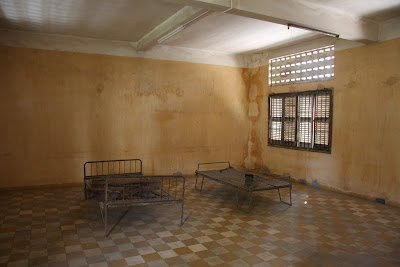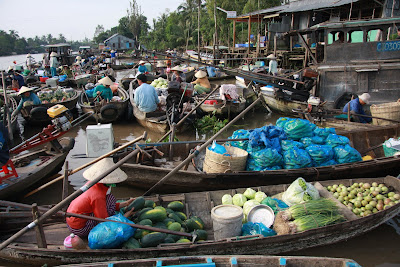 We crossed the border into Cambodia in one the most pleasant ways imaginable: a leisurely boat ride up the Mekong from the Vietnamese Mekong Delta region that took us to the very heart of Phnom Penh. The city’s romantic position on the confluence of the Mekong and Ton Le Sap rivers combined with the beautiful old French colonial buildings, glittering pagodas, ornate Khmer architecture, wide boulevards and open green spaces and largely traffic free roads (at least by Asian standards) make Phnom Penh one of the most appealing cities we’ve been to. We visited it twice: when we arrived in Cambodia and again when we returned from the north-east of the country.
We crossed the border into Cambodia in one the most pleasant ways imaginable: a leisurely boat ride up the Mekong from the Vietnamese Mekong Delta region that took us to the very heart of Phnom Penh. The city’s romantic position on the confluence of the Mekong and Ton Le Sap rivers combined with the beautiful old French colonial buildings, glittering pagodas, ornate Khmer architecture, wide boulevards and open green spaces and largely traffic free roads (at least by Asian standards) make Phnom Penh one of the most appealing cities we’ve been to. We visited it twice: when we arrived in Cambodia and again when we returned from the north-east of the country.As with the other land borders we’ve crossed, we were struck on entering Cambodia by how immediately it differed from Vietnam. There are of course many similarities between the two: the landscape, the French colonial influence, the bustling street life and profusion of people. Yet as apparent were the differences: the conical hats that were so ubiquitous in Vietnam changed to kramas, (the checked scarves Cambodians use to keep the sun and dust off their heads); poverty is more evident in Cambodia, with more beggars than we’ve seen elsewhere on this trip; yet despite feeling generally poorer there are far more cars and 4x4s in Cambodia and motorbikes no longer dominate the roads as they did in Vietnam; and life seems to operate at a slower and more relaxed pace.

Phnom Penh is remarkably low rise for a capital city, with most buildings only one to three storeys high and only one high rise tower in the city (though this appears to be changing with large construction projects underway). Architecturally the city is a happy mix of French colonial, neo-classical, traditional Khmer and modern concrete buildings. The heart of Phnom Penh is the bustling riverfront area, where one bank of the Ton Le Sap is lined with hotels, bars, restaurants, tuk-tuks (motorbike towed carriages), beggars and amputee book sellers. Luckily the opposite bank of the river has not yet been developed and we spent several evenings watching sunset over the river and open countryside beyond from the terrace of the Foreign Correspondents Club, a fabulous art deco bar where we could almost pretend we were travelling in the “golden age” of tourism in Indochina. While the colonial era may have ended there seems a lingering expat population comprising numerous UN, NGO and aid agency workers.

The most spectacular structure on the riverfront is the Royal Palace, comprised of numerous richly decorated buildings set in immense ornamental gardens. The buildings are designed in the distinctive Khmer style, with high, steeply pitched and curling roofs supported by slender columns and topped by tall thin spires. The roofs are tiled in bright orange and green, with the tips lavishly decorated in gold. Like the temples we’ve seen around the country, the Royal buildings are all comprised of a single large room lifted above the ground on an enormous solid platform. Built in 1866 it has been occupied almost continuously by the Kings of Cambodia, and much of the complex remains the Royal residence.

The National Museum housed one of the most beautiful collections of art we’ve visited. While the Museum itself is built in the same modern Khmer style as the nearby Royal Palace, the fabulous collection of Hindu and Buddhist sculpture it holds was produced during the Angkor era and is evidence of the great ancient Khmer civilisation which dominated South East Asia between the 9th and 14th Centuries. Although Buddhism came to Cambodia with Hinduism in the early Angkorian Period it was initially subordinate to it, and only became the official religion of Cambodia during the 13th Century. Since then all Cambodian men, including the King, have traditionally spent a year of their life as a monk. Most monks were disrobed during the Khmer Rouge period (1975-79) and many of the temples were destroyed, but today Buddhism is again the state religion and plays a large part in daily life. Wat Ounalom, the centre of Cambodian Buddhism, is just behind the Royal Palace and we frequently saw young monks clothed in bright yellow or orange robes wandering the streets of the capital.
Looking at Phnom Penh now it’s hard to imagine the horrors the people of Cambodia experienced just over 30 years ago under the extreme communist Khmer Rouge regime, when an estimated two million Cambodians (over one in four of the population) were killed. The Khmer Rouge took control of the country in 1975 after five years of civil war and embarked on a process of social restructuring, more radical than the world had ever seen. Their aim was to take the country back to “Year Zero” by creating a peasant dominated agrarian society with no money, mechanisation or intellectual life. In a bid to destroy the old ‘exploitive society’ of the towns and cities, they evacuated Phnom Penh within just five days of seizing power. This led to an exodus of two million people into the countryside leaving the capital looted, destroyed and empty for the entirety of the Khmer Rouge’s 3 year and 8 month rule. Video footage we saw of the evacuation and the empty city left behind was heartbreaking.

Tuol Sleng, or S21, is the most harrowing reminder we saw of the suffering unleashed by the Khmer Rouge. This former high school turned prison (photo above) became the largest detention and torture centre in Cambodia and held over 17,000 people of whom only seven were still alive when the Vietnamese liberated the city in 1979. The prison is all the more chilling as on the surface it seems so ordinary and peaceful and simply like the school it once was: there are still blackboards on some of the classroom walls, gardens with exercise frames and shady palm trees. However once inside you see the classrooms are divided into solitary confinement cells, or into interrogation rooms equipped with iron beds and iron shackles. Outside the play frames were used as gallows to suspend prisoners by their feet and torture them. Like the Nazis, the Khmer Rouge kept meticulous records of those held in the camp and classroom after classroom contains hundreds of devastating pictures of those who were detained and later killed, often taken both before and after torture. The museum’s final display focused on the long overdue trial that has now started of four former Khmer Rouge leaders, who’d lived freely for many years – at great anger to many Cambodians. Whilst stopping short of the sort of “truth and reconciliation process” seen in South Africa and Liberia, the trials represent an effort to reconcile the country and its recent past, although it remains to be seen whether the process will keep up with the ageing Khmer Rouge leaders, two of whom have already died in custody.
























